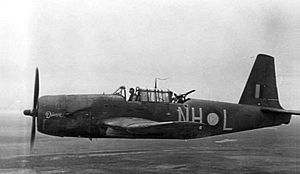No. 12 Squadron RAAF
| No. 12 Squadron RAAF | |
|---|---|

A No. 12 Squadron Vengeance in 1943
|
|
| Active | 1939–48 1973–89 |
| Country | Australia |
| Branch | Royal Australian Air Force |
| Role | General purpose (1939–43) Bomber (1943–48) Transport (1973–89) |
| Motto(s) | "We roam and we charge" |
| Engagements | World War II |
| Commanders | |
| Notable commanders |
Charles Eaton (1939–40) |
| Insignia | |
| Squadron code | M, NH |
| Aircraft flown | |
| Bomber | Anson, Vengeance, Liberator, Lincoln |
| Fighter | Demon |
| Helicopter | Chinook |
| Trainer | Wirraway |
No. 12 Squadron was a Royal Australian Air Force (RAAF) general purpose, bomber and transport squadron. The squadron was formed in 1939 and saw combat in the South West Pacific theatre of World War II. From 1941 to 1943, it mainly conducted maritime patrols off northern Australia. The squadron was based at Merauke in western New Guinea from November 1943 to July 1944, when it was withdrawn from operations. After being re-equipped, it operated as a heavy bomber unit from February 1945 until the end of the war. The squadron continued in this role until it was redesignated No. 1 Squadron RAAF in February 1948. The squadron was reformed in 1973 to operate transport helicopters but was again disbanded in 1989.
No. 12 Squadron was formed as a general purpose unit at RAAF Base Laverton on 6 February 1939 under the command of Squadron Leader Charles Eaton. The squadron was initially equipped with four Hawker Demon biplane fighters and four Avro Anson maritime reconnaissance aircraft and commenced intensive training in May. No. 12 Squadron began to move to Darwin in July 1939, with its advance party arriving there on the 24th of the month. The squadron was the first RAAF unit to be permanently based in the Northern Territory and was initially stationed at Darwin's civil aerodrome. Seven No. 12 Squadron Ansons were based in Darwin by late August, and these began flying reconnaissance patrols on the last day of the month. The Demons were replaced with CAC Wirraway general purpose aircraft at Laverton on 1 September, and all of the squadron's aircraft had arrived in Darwin by 17 September. The squadron's flying was reduced during September and October to make personnel available to improve the aerodrome's facilities, but by the end of October it had returned to normal operations. These included escorting shipping, maritime reconnaissance and coastal patrols.
...
Wikipedia
